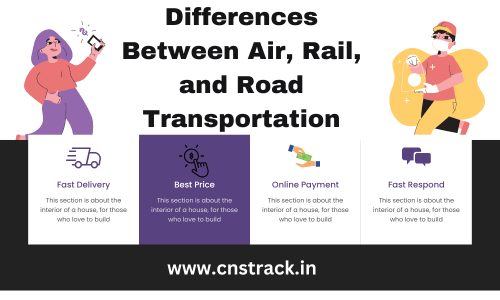Differences Between Air Rail and Road Transportation: In the world of logistics and transportation, the movement of goods is the backbone of many industries. Different modes of transportation are used to efficiently transport materials and products from one place to another.
In this blog post, we will explore and clarify the distinctions between three primary modes of transportation: Air Cargo, Rail Cargo, and Road Transportation. Each of these modes serves a unique purpose and offers specific advantages, making them crucial components of the global supply chain. So, let’s dive into the intricacies of these transportation methods and understand how they differ from one another.
Differences Between Air Rail and Road Transportation in Simple way
Transportation is a vital component of any country’s infrastructure, and in a vast and diverse nation like India, the choice of transportation mode can significantly impact the movement of goods and people. Air, rail, and road transportation are the primary pillars of India’s logistics and transportation network, each with its own set of advantages and limitations. Understanding the differences between these modes is crucial for businesses, travelers, and policymakers alike. In this article, we’ll delve into the distinctions between air, rail, and road transportation in India, shedding light on when and why each mode is preferred.
Air Cargo Transportation
Air cargo transportation, as the name suggests, involves the movement of materials via aircraft. This mode of transportation is known for its speed and efficiency, making it ideal for transporting goods over long distances in a short amount of time. Air cargo is often used for high-value, time-sensitive, or perishable goods. It is the preferred choice for industries where rapid delivery is critical, such as the medical and electronics sectors.
One of the key advantages of air cargo is its global reach. It allows businesses to access markets worldwide quickly. Additionally, air cargo can bypass many of the infrastructure challenges associated with ground transportation, such as road conditions and customs delays. However, it is essential to note that air cargo transportation is typically more expensive than other modes due to the cost of airfreight and airport handling fees.
Rail Cargo Transportation
Rail cargo transportation involves the movement of materials via railways. Rail transport is known for its cost-effectiveness when moving large quantities of goods over long distances. Rail cargo companies utilize various types of railcars, including Standard Loading Railcars (SLRs), Freight Container Rail, and Vehicle and Passenger Handling Railcars (VPH), depending on the nature of the cargo being transported.
Rail transport offers several advantages, such as high capacity and reduced fuel consumption per ton-mile compared to road transportation. It is often used for bulk commodities like coal, grain, and minerals. Rail transport is also eco-friendly, as it produces fewer emissions per ton of cargo moved compared to other modes of transportation. However, it may not be as fast as air or road transport, making it less suitable for time-sensitive shipments.
Road Transportation
Road transportation involves the movement of materials using various types of vehicles on roads. It is the most flexible mode of transportation, allowing goods to be delivered directly to their destination, including remote areas with limited access to other modes of transport. Road transportation is commonly used for local and regional deliveries, as well as for the final leg of longer journeys when goods are transported from a transportation hub to their ultimate destination.
One of the significant advantages of road transportation is its accessibility and versatility. It can accommodate a wide range of cargo types, from small parcels to oversized equipment. Road transport also provides door-to-door service, allowing for easy pick-up and delivery. However, it may not be as cost-effective for long-distance transportation of large volumes of goods compared to rail or sea transport.
In summary, each mode of transportation—air, rail, and road—serves a specific purpose and offers distinct advantages. The choice of transportation mode depends on factors such as the nature of the cargo, the required delivery speed, cost considerations, and the accessibility of transportation infrastructure.
Understanding these differences is essential for businesses to make informed decisions about how to move their goods efficiently and effectively in today’s complex supply chain landscape.
You Can Track Also
👉 RSMSSB Recruitment 2024: 64,265 पदों पर सरकारी नौकरी का सुनहरा अवसर


